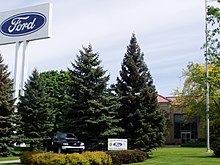Twin Cities Assembly Plant
In 1912, the first assembly and sales activities were started in a former warehouse in Minneapolis[1] by Ford Motor Company. By 1925, the Twin Cities Assembly Plant had relocated next to the Mississippi River in the Highland Park neighborhood of St. Paul, Minnesota, United States. It was in operation from 1925 to 2011. At the time of its closure, it was the oldest Ford plant still in operation.
The plant's final products were the Ford Ranger pickup truck. Previously, the plant had manufactured the Ford Model T, Model TT truck, Sportsman convertible, Galaxie, and LTD.
In 2006, Ford officials announced plans to close the factory, though it operated for three years past the 2008 closure date initially announced. The plant's final truck was completed on December 16, 2011. Most of the buildings have been demolished since then.
Contents
Construction[edit]

The promise of cheap hydropower was the chief reason why Henry Ford agreed to build a plant in St. Paul. The dam was initially completed in 1917, making it one of the oldest on the river. However, hydroelectric power required a rather large dam, which meant that the first lock and dam built on the Mississippi would have to be demolished. Some remains of the upstream Meeker Island Lock and Dam still poke out of the water when the river is low. A major upgrade to the Ford Dam was completed in 1929, and the completion of locks by the U.S. Army Corps of Engineers followed in 1932. The dam was acquired by Brookfield Renewable Power in April 2008.[2]
The Ford name is also attached to a nearby bridge, completed in 1927. Officially known as the Intercity Bridge, it connects 46th Street on the Minneapolis side of the river to the Ford Parkway in St. Paul.
Glass production[edit]
From 1926 to 1959, the plant produced glass for vehicle windows with silica mined from sandstone on site. The resulting tunnels underneath the plant remain.
Productivity[edit]
In 2004, a vehicle took an average of 20.77 hours of labor to roll through the assembly line, 3.5 hours faster than might be expected in comparison to other plants.
Closure plans[edit]
The plant was rumored to be among the plants that were expected to be closed when company officials revealed restructuring plans dubbed The Way Forward on January 23, 2006.[3] The St. Paul plant was not included among the initial list of plant closings announced in January.[4] However, Ford announced on April 13 that the Twin Cities plant would close in 2008, along with the Norfolk, Virginia Ford F-series pickup plant.[5][6] Ranger production has dropped from a peak of nearly 300,000 units in 1998, to under 120,000 in 2005. First quarter 2006 sales for the Ranger were under 22,500—down another 16% from 2005. While other Ford plants were operating at an average capacity of 75% in 2004, the Twin Cities Plant beat that average with 83%, but higher than average productivity was not enough to hold off the plant's ultimate closure.
On July 24, 2008, Ford announced they would keep the Twin Cities Plant open through 2011.[7]
The plant produced its last vehicle on December 16, 2011 and has been closed.[8] Ford plans to tear down most of the building on the site, beginning in the summer of 2012.[9] Redevelopment plans will depend on the findings of pollution tests.[10] Cleanup efforts are expected to be complete by mid-2019.[11]
See also[edit]
References[edit]
- ^ Twin Cities Assembly Plant 100th Anniversary
- ^ Twin Cities Hydroelectric Facility information page, City of St. Paul website
- ^ Meyers, Mike (December 2, 2005). "Ford plant's strengths may not save it". StarTribune. Minneapolis.
- ^ Sweeney, Patrick (January 23, 2006). "St. Paul Ford plant to stay open, at least for now". Pioneer Press. Saint Paul.
- ^ "Ford's Twin Cities and Norfolk Assembly Plants Will Be Idled as Way Forward Plan Moves Ahead". Media.Ford.com. April 13, 2006.
- ^ "St. Paul's Ford plant to close". Minnesota Public Radio. April 13, 2006.
- ^ Vomhof, John (July 24, 2008). "St. Paul Ford plant staying open through 2011". Minneapolis St. Paul Business Journal.
- ^ Sitaramiah, Gita (December 16, 2011). "At Ford's St. Paul plant, it's quitting time". Pioneer Press. Saint Paul.
- ^ Bjorhus, Jennifer (December 16, 2011). "Much disassembly required at Ford plant". StarTribune. Minneapolis.
- ^ Moore, Janet (December 12, 2011). "Ford plant sits on 122 prime acres". StarTribune. Minneapolis.
- ^ "Project Timing". Saint Paul, Minnesota. 2015-10-19. Retrieved 2017-07-24.
External links[edit]
- USACE: Lock and Dam No. 1
- Ford Assembly Plant Mining Tunnels (History & Exploration)
- City of Saint Paul: Ford Parkway Bridge
Coordinates: 44°54′50″N 93°11′45″W / 44.91389°N 93.19583°W


